 W
WAutomatic number-plate recognition is a technology that uses optical character recognition on images to read vehicle registration plates to create vehicle location data. It can use existing closed-circuit television, road-rule enforcement cameras, or cameras specifically designed for the task. ANPR is used by police forces around the world for law enforcement purposes, including to check if a vehicle is registered or licensed. It is also used for electronic toll collection on pay-per-use roads and as a method of cataloguing the movements of traffic, for example by highways agencies.
 W
WAutomatic number plate recognition (ANPR) is a technology for automatically reading vehicle number plates. The Home Office states ANPR is used by law enforcement agencies in the United Kingdom to help detect, deter and disrupt criminality including tackling organised crime groups and terrorists.
 W
WBallistic shields are protection devices deployed by police and military forces that are designed to stop or deflect bullets and other projectiles fired at their carrier. Ballistic shields will also protect from less serious threats such as thrown items, though they are typically used in situations where riot shields would not offer adequate protection.
 W
WBarricade tape is brightly colored tape that is used to warn or catch the attention of passersby of an area or situation containing a possible hazard. It acts as a minor impediment to prevent accidental entrance to that area or situation and as a result enhances general safety. Barricade tape is also known as construction tape or barrier tape or in reference to the safety hazard involved as caution tape, warning tape, danger tape or hazard tape. When used by a police force, the tape is named police tape.
 W
WA baton or truncheon is a roughly cylindrical club made of wood, rubber, plastic or metal. It is carried as a compliance tool and defensive weapon by law-enforcement officers, correctional staff, security guards and military personnel.
 W
WA police box is a public telephone kiosk or callbox for the use of members of the police, or for members of the public to contact the police. It was used in the United Kingdom throughout the 20th century from the early 1920s. Unlike an ordinary callbox, its telephone was located behind a hinged door so it could be used from the outside, and the interior of the box was, in effect, a miniature police station for use by police officers to read and fill in reports, take meal breaks and even temporarily hold detainees until the arrival of transport.
 W
WA breathalyzer or breathalyser is a device for estimating blood alcohol content (BAC) from a breath sample.
 W
WA bullbar or push bumper (also called a roo bar or nudge bar in Australia, a moose bumper in Canada, and a push bar, PIT guard, PIT bar, PIT bumper, ram bar, ram bumper, brush guard, bumper bar, grille bar, grille guard, rammer or cattle pusher, is a device installed on the front of a vehicle to ram other with front on collisions, whether an accidental collision with a large animal in rural roads, or an intentional collision by police with another vehicle, usually during pursuits. They range considerably in size and form, and are normally composed of welded steel or aluminium tubing, or, more recently, moulded polycarbonate and polyethylene materials. The "bull" in the name refers to cattle, which in rural areas sometimes roam onto rural roads and highways.
 W
WA chowky is a police workstation, gatehouse or police box in the Indian Police, and is the basic unit of police presence in any area. Each chowky is under the charge of a sub-inspector. There are typically more chowkies than stations in a state police force, for example in Maharashtra.
 W
WA clipboard is a thin, rigid board with a clip at the top for holding paper in place. A clipboard is typically used to support paper with one hand while writing on it with the other, especially when other writing surfaces are not available. The earliest forms were patented in 1870-71 and referred to as board clips. Related to the clipboard is the Shannon Arch File, which was developed around 1877.
 W
WA dashboard camera or simply dashcam, also known as car digital video recorder, driving recorder, or event data recorder (EDR), is an onboard camera that continuously records the view through a vehicle's front windscreen and sometimes rear or other windows. Some dashcams include a camera to record the interior of the car in 360 degrees inside camera, usually in a ball form and can automatically send pictures and video using 4G.
 W
WA police duty belt is a belt, typically constructed of nylon or leather used by police, prison and security officers to carry equipment easily in a series of pouches attached to the belt, in a readily-accessible manner, while leaving the hands free to interact. This belt can carry any number of useful items, ranging from handcuffs to guns.
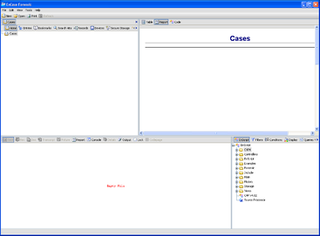 W
WEnCase is the shared technology within a suite of digital investigations products by Guidance Software. The software comes in several products designed for forensic, cyber security, security analytics, and e-discovery use. Encase is traditionally used in forensics to recover evidence from seized hard drives. Encase allows the investigator to conduct in depth analysis of user files to collect evidence such as documents, pictures, internet history and Windows Registry information.
 W
WEnforcer is the term given to a specially designed manual battering ram manufactured by Sigma Security Devices Ltd (www.sigmasecuritydevices.com) and currently used by British Police forces, fire services and other agencies to aid in gaining entry to premises in confined spaces.
 W
WThe Euatel is a patrol vessel operated by Palau's Division of Marine Law Enforcement. She was donated to Palau by the Nippon Foundation and Sasakawa Peace Foundation. She is the third vessel of her class to be donated to Palau. She was delivered on April 25, 2017, and her sister ships, Kabekl M’tal and Bul in 2015 and 2012.
 W
WSaab’s GAMER Manpack is used in smaller military exercises when the instructor wants to have control of the exercise and at the same time be able to be near the action. The actual GAMER Manpack consists of a miniaturised radio base station and a laptop with an exercise-command-and-control system. These are small enough to be carried around in a backpack.
 W
WThe Guardian-class patrol boats are a class of small patrol vessels designed and built in Australia for small Pacific Ocean countries.
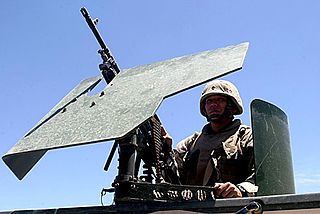 W
WA gun shield is a flat piece of armor designed to be mounted on a crew-served weapon such as a machine gun or artillery piece, or, more rarely, to be used with an assault rifle.
 W
WA handcuff cover is a piece of plastic or metal that can be placed around a pair of handcuffs. It consists of a hinged, box-like assembly locked over the handcuff chain, wristlets and keyholes.
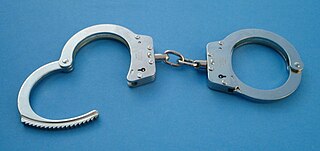 W
WHandcuffs are restraint devices designed to secure an individual's wrists in proximity to each other. They comprise two parts, linked together by a chain, a hinge, or rigid bar. Each cuff has a rotating arm which engages with a ratchet that prevents it from being opened once closed around a person's wrist. Without the key, the handcuffs cannot be removed without specialist knowledge, and the handcuffed person cannot move his or her wrists more than a few centimetres or inches apart, making many tasks difficult or impossible.
 W
WSpeedcuffs are a model of handcuff characterised by their rigid grip between the two ratchet cuffs. Their rigid design and the inclusion of a grip makes them effective for gaining control over a struggling prisoner, even if only one cuff has been applied. They were standard issue for most police forces within the United Kingdom.
 W
WAn ignition interlock device or breath alcohol ignition interlock device is a breathalyzer for an individual's vehicle. It requires the driver to blow into a mouthpiece on the device before starting or continuing to operate the vehicle. If the resultant breath-alcohol concentration analyzed result is greater than the programmed blood alcohol concentration, the device prevents the engine from being started. The interlock device is located inside the vehicle, near the driver’s seat, and is directly connected to the engine’s ignition system. It is a form of electronic monitoring.
 W
WA kōban is a small neighborhood police station found in Japan. The term is also used to refer to the smallest organizational unit in a modern Japanese Prefectural police department. Small kōban buildings, staffed by uniformed officers at around 6,000 locations all over the country, are the bases for community policing activities which complement the work of larger, central police stations.
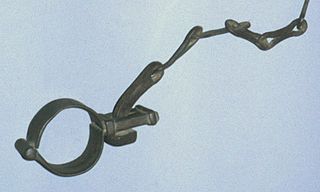 W
WLegcuffs are physical restraints used on the ankles of a person to allow walking only with a restricted stride and to prevent running and effective physical resistance.
 W
WLidar has a wide range of applications; one use is in traffic enforcement and in particular speed limit enforcement, has been gradually replacing radar since 2000. Current devices are designed to automate the entire process of speed detection, vehicle identification, driver identification and evidentiary documentation.
 W
WA machine pistol is a self-loading pistol capable of burst fire or fully automatic. It can also be occasionally used to specifically describe a stockless handgun-style submachine gun. The term is a calque of Maschinenpistole, the German word for submachine guns. Machine pistols were developed during World War I and originally issued to German artillery crews who needed a self-defense weapon that is lighter than a rifle but more powerful than a standard semi-automatic pistol. Today, they are considered a special purpose weapon with limited utility, and difficult to control for all but the best shooters.
 W
WMyeonje baegab (면제배갑, 綿製背甲) was a soft bulletproof vest invented in 1867 in the Joseon dynasty.
 W
WNon-lethal weapons, also called less-lethal weapons, less-than-lethal weapons, non-deadly weapons, compliance weapons, or pain-inducing weapons are weapons intended to be less likely to kill a living target than conventional weapons such as knives and firearms. It is often understood that unintended or incidental casualties are risked wherever force is applied, but non-lethal weapons try to minimise the risk of casualties as much as possible. Non-lethal weapons are used in policing and combat situations to limit the escalation of conflict where employment of lethal force is prohibited or undesirable, where rules of engagement require minimum casualties, or where policy restricts the use of conventional force. These weapons occasionally cause serious injuries or death; the term "less-lethal" has been preferred by some organizations as it describes the risks of death more accurately than the term "non-lethal", which some have argued is a misnomer.
 W
WA police notebook, pocket notebook or PNB is a notebook used by police officers in the United Kingdom to officially record details and incidents while on patrol. Its use is controlled by a number of guidelines, as information entered into an officer's PNB is admissible in court, and the officer will use it to refresh their memory while giving evidence, and to support their statements.
 W
WThe Pacific-class is a class of 22 patrol boats built by Australia and donated to twelve South Pacific countries. They were constructed between 1985 and 1997 and are operated by militaries, coast guards or police forces of twelve island nations. These boats are supported by the Pacific Patrol Boat Program and used primarily for maritime surveillance and fisheries protection.
 W
WThe personnel halting and stimulation response rifle (PHASR) is a prototype non-lethal laser dazzler developed by the Air Force Research Laboratory's Directed Energy Directorate, U.S. Department of Defense. Its purpose is to temporarily disorient and blind a target. Blinding laser weapons have been tested in the past, but were banned under the 1995 UN Protocol on Blinding Laser Weapons, which the United States acceded to on 21 January 2009. The PHASR rifle, a low-intensity laser, is not prohibited under this regulation, as the blinding effect is intended to be temporary. It also uses a two-wavelength laser. The PHASR was tested at Kirtland Air Force Base, part of the Air Force Research Laboratory Directed Energy Directorate in New Mexico.
 W
WPlastic handcuffs are a form of physical restraint for the hands, using plastic straps. They function as handcuffs but are cheaper and easier to carry than metal handcuffs, and they cannot be reused. The device was first introduced in 1965.
 W
WIn policing equipment, a body camera or wearable camera, also known as body worn video (BWV) or body-worn camera (BWC), is a wearable audio, video, or photographic recording system used to record events in which law enforcement officers are involved. They are typically worn on the torso of the body on the officer's uniform. Body worn cameras for policing are often similar to other body worn video equipment used by civilians, firefighters, or the military, but are designed to address specific requirements related to law enforcement.
 W
WProVida is a series of mobile surveillance and speed limit enforcement systems produced by UK-based Petards Group. It was originally developed in 1986 by Danish company JaiVISION. Its first user was Rigspolitiet Denmark, the Danish national police force. Today ProVida recordings are accepted as proof in various jurisdictions including the United Kingdom.
 W
WA radar speed gun is a device used to measure the speed of moving objects. It is used in law-enforcement to measure the speed of moving vehicles and is often used in professional spectator sport, for things such as the measurement of bowling speeds in cricket, speed of pitched baseballs, and speed of tennis serves.
 W
WA red light camera is a type of traffic enforcement camera that captures image of vehicle that has entered an intersection in spite of the traffic signal indicating red. By automatically photographing vehicles that run red lights, the photo is evidence that assists authorities in their enforcement of traffic laws. Generally the camera is triggered when a vehicle enters the intersection after the traffic signal has turned red.
 W
WPrototype Designed by TFM Industries by a developer Steve van Rooyen. From a model scaled. The RG-12 is a multi-purpose armoured personnel carrier with anti-personnel mine, grenade, fire bomb and small arms fire protection that is manufactured by Land Systems OMC of South Africa, with over 700 being in service globally in more than eight countries.
 W
WA riot shield is a lightweight protection device, typically deployed by police and some military organizations, though also utlized by protestors. Riot shields are typically long enough to cover an average-sized person from the top of the head to the knees, though smaller one-handed models may also be used. They are generally intended to be used in riot control, to protect the user from melee attacks with blunt or edged weapons and also thrown projectiles, or non-lethal weapons such as rubber bullets and water cannons. They can also be used as short-ranged melee weapons to push back the opposing force. Most riot shields do not offer ballistic protection; ballistic shields are instead used in situations where heavily armed resistance is expected.
 W
WA Rumbler siren is a type of emergency vehicle siren used primarily in the United States. Developed in 2007 by Federal Signal Corporation, and sounding at a low-frequency level, it is designed to be heard by motorists who may otherwise be unable to hear high-frequency sirens due to ambient noise, such as urban traffic.
 W
WSmartWater is a traceable liquid and forensic asset marking system (taggant) that is applied to items of value to identify thieves and deter theft. The liquid leaves a long lasting and unique identifier, whose presence is invisible except under an ultraviolet black light.
 W
WA spike strip is a device or incident weapon used to impede or stop the movement of wheeled vehicles by puncturing their tires. Generally, the strip is composed of a collection of 35-to-75-millimetre-long metal barbs, teeth or spikes pointing upward. The spikes are designed to puncture and flatten tires when a vehicle is driven over them; they may be detachable, with new spikes fitted to the strip after use. The spikes may be hollow or solid; hollow ones are designed to detach and become embedded in the tires, allowing air to escape at a steady rate to reduce the risk of the driver losing control and crashing. One type was co-invented by Donald Kilgrow, a retired Utah Highway Patrol trooper, along with a design engineer. They are historically a development of the caltrop, anti-cavalry and anti-personnel versions being used as early as 331 BC by Darius III against Alexander the Great at the Battle of Gaugamela in Persia.
 W
WA stab vest or stab proof vest is a reinforced piece of body armor, worn under or over other items of clothing, which is designed to resist knife attacks to the chest, back and sides. Stab vests are different from bulletproof vests, most of which offer protection against firearms but afford little against stabbing with sharp-tipped objects such as knives; most stab vests afford less protection against bullets, particularly those of high caliber, but are designed to prevent serious injury by prohibiting knife penetration beyond a few millimeters. Stab vests are also needle and slash proof.
 W
WThe StingRay is an IMSI-catcher, a cellular phone surveillance device, manufactured by Harris Corporation. Initially developed for the military and intelligence community, the StingRay and similar Harris devices are in widespread use by local and state law enforcement agencies across Canada, the United States, and in the United Kingdom. Stingray has also become a generic name to describe these kinds of devices.
 W
WA submachine gun, abbreviated SMG, is a magazine-fed, automatic carbine designed to fire handgun cartridges. The term "submachine gun" was coined by John T. Thompson, the inventor of the Thompson submachine gun, to describe its design concept as an automatic firearm with markedly less firepower than a machine gun.
 W
WA swagger stick is a short stick or riding crop usually carried by a uniformed person as a symbol of authority. A swagger stick is shorter than a staff or cane, and is usually made from rattan. Its use derives from the vine staff carried by Roman centurions as an emblem of office.
 W
WA traffic enforcement camera is a camera which may be mounted beside or over a road or installed in an enforcement vehicle to detect motoring offenses, including speeding, vehicles going through a red traffic light, vehicles going through a toll booth without paying, unauthorized use of a bus lane, or for recording vehicles inside a congestion charge area. It may be linked to an automated ticketing system.
 W
WTransportation for police forces is provided by a number of ground vehicles, aircraft and watercraft.
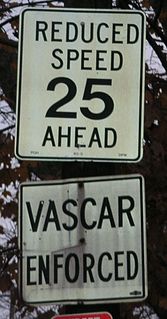 W
WVASCAR is a type of device for calculating the speed of a moving vehicle. The first VASCAR device was created in 1966 by Arthur Marshall. It is used by police officers to enforce speed limits, and may be preferred where radar or lidar is illegal, such as some jurisdictions in Pennsylvania, or to prevent detection by those with radar detectors.
 W
WA walkie-talkie, more formally known as a handheld transceiver (HT), is a hand-held, portable, two-way radio transceiver. Its development during the Second World War has been variously credited to Donald Hings, radio engineer Alfred J. Gross, Henryk Magnuski and engineering teams at Motorola. First used for infantry, similar designs were created for field artillery and tank units, and after the war, walkie-talkies spread to public safety and eventually commercial and jobsite work.